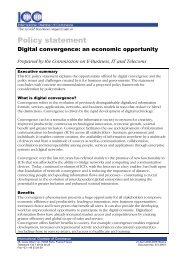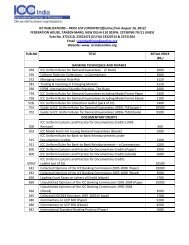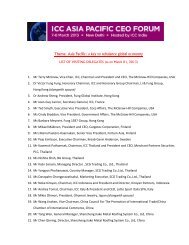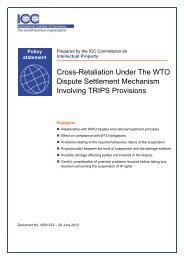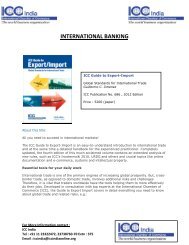2013 - ICC India
2013 - ICC India
2013 - ICC India
- No tags were found...
You also want an ePaper? Increase the reach of your titles
YUMPU automatically turns print PDFs into web optimized ePapers that Google loves.
<strong>ICC</strong> BANKING COMMISSION | <strong>2013</strong> GLOBAL RISKS TRADE FINANCE | APPENDIX C 63APPENDIX C.ENDNOTES1 This is the exposure-weighted economic loss rather than the transaction-weighted figure2 For example value imports and exports of middle market corporates in Germany, France,Italy, UK growing significantly stronger than overall trade; source: country import/exportstatistics3 World Trade Organization4 Economist Intelligence Unit5 The exporter could ship the goods and await payment upon delivery (or sometimethereafter), but this does expose them to the risk of non-payment (which might require anextra equity cushion) and a risk around timing of payments.6 This is a collective term for a range of instruments, which are backed by the underlying L/Cs.7 People often refer to the quality of capital or to its ability to “absorb” losses.8 It should be noted that participating banks only provide data by product, country and yearand that no bank has access to another bank’s data.9 This is as expected given the low default rates observed in the data coupled with the factthat many banks around the world face significant challenges in capturing LGD data.10 Given the multi-year tenor of these products, an individual transaction can potentiallyappear in multiple years – each occurrence is referred to as a “transaction-year”11 Basel uses ‘effective maturity’, which is a cash-flow weighted time duration measure, whichwe are unable to derive from the dataset. As such we have used a concept of ‘economicmaturity’ based on turnover – see footnote 20.12 This is based on Exhibit 31 of Moody’s (2012)13 Over the same period used for deriving the Trade finance parameters (2008-2011), theaverage observed annual issuer-weighted corporate default rates for Aa, A or Baa ratedcustomers were 0.14%, 0.22% and 0.36% respectively. We have not reported the figures ata more granular level over this period as the limited time frame and sample size for Moody’sproduces some non-monotonic results across grades.14 Based on Exhibit 31 in Moody’s (2012)15 One challenge in undertaking this comparison is that corporates who are externally ratedby the likes of Moody’s Investor Services tend to be larger, and hence might be expected tohave somewhat lower default rates than the typical users of Trade Finance products, whotend to be SMEs. Robust sources of country-level default rates are not readily available (andtrying to extract relevant information from banks’ Pillar 3 reports is challenging). However,in our experience, the typical default rate for SMEs tend to more than twice as high as thosefor the broad externally rated population (the ratio depends upon the specific definition ofsmall and medium sized firms as well as the geographical and sectoral split of a portfolio).16 In defining a recession we have use a technical definition of two quarters of negative GDPgrowth where quarterly data available, and a year of negative GDP growth for the smallnumber of countries where quarterly data was unavailable. Given that the Trade Registerdata is only provided on a yearly basis, we have classified the whole year as being inrecession if a recession occurred during the year.17 As this is an aggregated figure, some cyclical effects may be masked (or exaggerated) bystructural differences in default rates across countries interacting with the specific set ofcountries affected by the crisis. For example, if <strong>India</strong> and China have higher long-run averagedefault rates than say the US, then the default rate for recession years in our data may belower than for non-recession years because <strong>India</strong> and China did not report a year-on-yearreduction in GDP across this period, whereas the US did. In order to address potentialstructural differences in default rates across countries, we would need to determine countryspecific default rates in recessions and non-recessions, and then compare these using a fixedweighting on each country. However, we have not done this at this stage, as it would requiregranular analysis of the data, which might introduce “noise” due to increased sparsenessof data.18 Moody’s (2011) also reports a peak in 2009 in default rates for Financial Institutions rated bythem.19 This is calculated as the number of transactions on the balance sheet at the year-end /the number of transactions during the year. Some of the implicit assumptions within thiscalculation are described in the appendix. However, it does appear broadly consistentwith the results from SWIFT in last year’s report that close to 90% of letters of creditexpire within 90 days. In addition, as this report was being finalised some banks providedinformation on the actual maturities of their products, but there was insufficient time toanalyse this fully and investigate differences for this year’s report.



